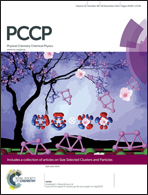Revisiting electroaccepting and electrodonating powers: proposals for local electrophilicity and local nucleophilicity descriptors
Abstract
The electrophilicity index, μ2/2η, where μ is the chemical potential and η is the hardness, has been defined by Parr, Von Szentpaly, and Liu (J. Am. Chem. Soc., 1999, 121, 1922) as the lowering in energy of an electronic system during a process in which the chemical potential of the system raises from μ to zero, accepting −μ/η electrons. In this work, it is shown that the electrophilicity index is also a rational choice for measuring nucleophilicity. Indeed, within the grand canonical ensemble, when the chemical potential of a system increases from μ to zero, the system gives away μ/η electrons. During the process, the variation of the grand potential is μ2/2η. Additionally, through the use of a second order Taylor series expansion of the density as a function of the number of electrons, at constant external potential, which depends on the Fukui function and the dual descriptor, the local electrophilicity is defined as the actual variation of the electron density when the system acquires −μ/η electrons, while the local nucleophilicity is similarly defined for the case when the system loses μ/η electrons.


 Please wait while we load your content...
Please wait while we load your content...